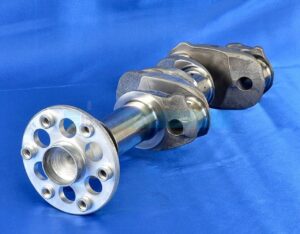As I’m getting ready to re-assemble my wife’s O-360-A1A, I have spent a lot of time looking up part numbers. Not, as it turns out, that I need to buy any of the big parts (everything seems to have checked out just fine at the machine shop), but before I got the good news from the guys with the calipers, I of course was looking to see just what a crankshaft might cost. And in order to do that, I had to know the part number for the crankshaft for a plain-Jane, O-360-A1A, the starting point for all the alphabet-soup designations of the engines. Simple – carbureted, constant speed prop with two magneto holes and a spot for a governor.

Of course I own an up-to-date copy of the Overhaul Manual for the Lycoming Horizontally-Opposed engines. And, of course, that is not where you go to find part numbers. Nope—for those, you go to the Parts Catalog. Since these engines go back many, many years, and changes to certified engines are costly in terms of approvals and paperwork, nothing changes very fast. The latest Overhaul Manual is, in fact dated 1974, with the most recent update in June of 1996. But the lack of updates to the documentation doesn’t mean that Lycoming’s engineering department doesn’t stay busy In fact, they make updates to parts on a frequent basis, and when they do, they update the part number. There are also, of course, updates to part numbers that have nothing to do with changing the part itself – updating inventory systems and modernizing databases are also responsible for what you’ll soon find is a bewildering array of nomenclature for might what very well be identical chunks of metal.
If you look at the latest parts manual catalog which is identified as being for the O-360-A1A, you’ll find a date of July 1980. Yes, there are later parts manuals for various O-360s – but you need to read carefully. The most up-to-date one is actually for the older narrow-deck engine, not the newer wide deck motor. So we go to the tried and true version that came out while I was still studying for my engineering degree (I have now been retired from my primary engineering career for seven years…). If we look at what appear to be hand-drafted drawings and tables typed on a type-writer, and reproduced endlessly so the digits start to run together, we find a crankshaft for the A1A to have a part number of 74966. Boom – we’re done… right?
 Far from it! I challenge you to find anyone online that sells such a critter. Nope, that part number has ben superseded… but to what? If you spend a couple of hours searching various parts suppliers, you’ll eventually come to the conclusion that what you actually want for this engine is a 13B47120. Or, at least, that seems to be the number, to a high degree of confidence, if not certainty. How do we reach certainty? We go looking for a Lycoming document known as SSP-499C, the Numerical Parts History. This 243 page book of tables shows part numbers (in alphanumeric order) and what those part numbers have changed into. So we look up the 74966, and find that it was superseded by an LW-17160 (I learned in Lycoming school that the “LW” means it was a part made by Lycoming in Williamsport – you can win a bar bet with that piece of trivia). Ahhh… but no, you can’t find a crankshaft with that number at Aircraft Spruce or Aircraft Specialties. So back to the table. Scroll down and find LW-17160, and lo and behold – it has been superseded by 13B-17160. At least they kept the same last number.
Far from it! I challenge you to find anyone online that sells such a critter. Nope, that part number has ben superseded… but to what? If you spend a couple of hours searching various parts suppliers, you’ll eventually come to the conclusion that what you actually want for this engine is a 13B47120. Or, at least, that seems to be the number, to a high degree of confidence, if not certainty. How do we reach certainty? We go looking for a Lycoming document known as SSP-499C, the Numerical Parts History. This 243 page book of tables shows part numbers (in alphanumeric order) and what those part numbers have changed into. So we look up the 74966, and find that it was superseded by an LW-17160 (I learned in Lycoming school that the “LW” means it was a part made by Lycoming in Williamsport – you can win a bar bet with that piece of trivia). Ahhh… but no, you can’t find a crankshaft with that number at Aircraft Spruce or Aircraft Specialties. So back to the table. Scroll down and find LW-17160, and lo and behold – it has been superseded by 13B-17160. At least they kept the same last number.
Continuing the chase, the 13B-17160 changed to a 13B-27120, which then changed to a 13B-47120. Magically, you can find that Aircraft Specialties can, in fact ship you a 13B-47120 in just two days! Unfortunately, the 47120 is listed in SSP-499C as a “Bushing Assembly”, not a crankshaft – but Aircraft Specialties has a picture of a crankshaft by this number, so I figure the person proofreading the Lycoming document was cross-eyed by the time they got to page 193.
So there you have it – the complete lineage of but one part of an O-360-A1A. Everything you need to know if you need to order a crankshaft… except, of course, how to obtain a mortgage to pay for it.














Sounds like too much fun. It’s why I bought a new Titan O-320 and sold the runout Lycoming version when the time came.